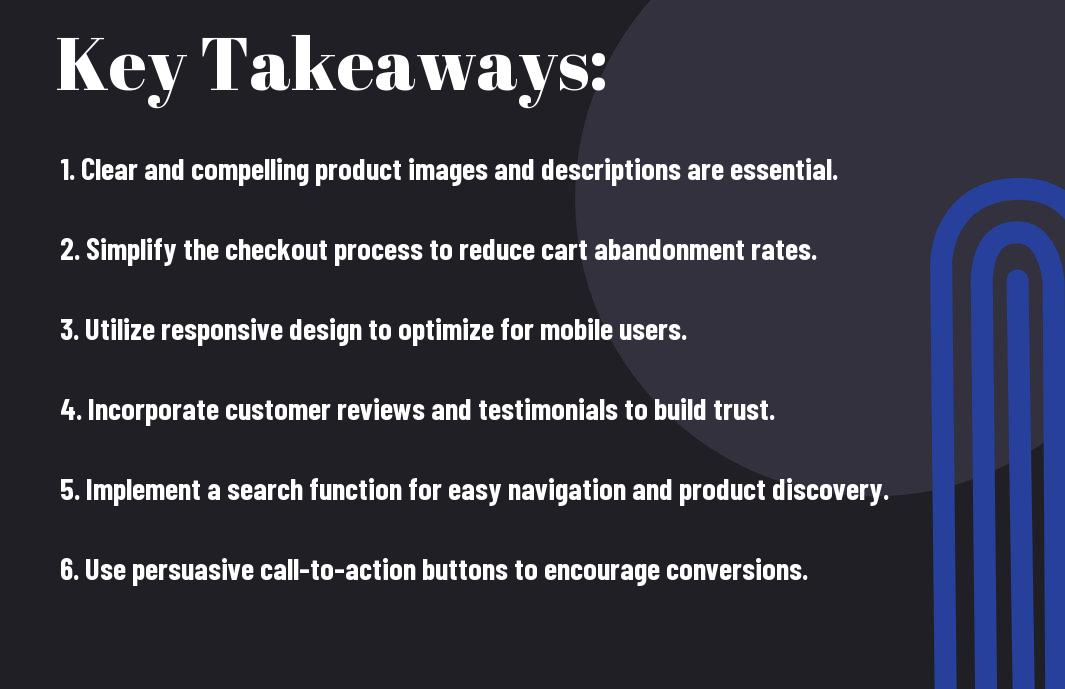Welcome to our latest blog post where we will be sharing valuable insights on how you can design an e-commerce website that effectively drives conversions and sales. As a business owner, it is crucial to have an online presence that not only attracts potential customers but also encourages them to make a purchase. In this article, we will discuss the key elements and strategies that you can implement to optimize your e-commerce website and generate significant sales. By implementing these tips, you can dramatically improve the performance of your online store and ultimately increase your revenue.
Key Takeaways:
- User-Friendly Design: Design a website that is easy to navigate and search for products, with clear calls to action and intuitive user interface.
- Mobile Optimization: Ensure your website is responsive and optimized for mobile devices to reach a wider audience and provide a seamless shopping experience.
- High-Quality Imagery: Use high-resolution images and visuals to showcase products, providing customers with a clear and attractive representation of what they are purchasing.
- Streamlined Checkout Process: Simplify the checkout process to reduce cart abandonment, by minimizing the number of steps required and offering various payment options.
- Strategic Call-to-Actions: Implement strategic call-to-action buttons and prompts to guide customers towards making a purchase, such as “Add to Cart” and “Proceed to Checkout”.


User Experience (UX) Design Principles
Assuming you want your e-commerce website to be successful, it is crucial to pay attention to user experience (UX) design principles. A well-designed website not only attracts customers but also keeps them engaged and encourages them to make purchases. For more in-depth tips on e-commerce website design, you can also refer to 10 Ecommerce Website Design Tips to enhance your understanding of UX principles and their impact on your website’s performance.
Navigation and Layout for Better Usability
When it comes to e-commerce websites, the navigation and layout play a critical role in providing a seamless user experience. Your website’s navigation should be simple, intuitive, and user-friendly. Ensure that visitors can easily find what they are looking for by implementing clear categories, filters, and a search function. Additionally, a well-organized layout can improve your website’s usability by making it easy for visitors to browse through your product offerings and access essential information such as pricing, product details, and shipping policies.
Mobile Responsiveness and Cross-Platform Compatibility
In today’s digital landscape, mobile responsiveness is non-negotiable. With a growing number of consumers using their smartphones and tablets for online shopping, your e-commerce website must be optimized for a seamless mobile experience. This includes implementing a responsive design that adapts to various screen sizes and ensuring that all features and functionalities are fully accessible across different devices and platforms. Neglecting mobile responsiveness can result in a significant loss of potential customers and sales.
Visual and Content Strategies
Despite the numerous factors that influence e-commerce conversion rates, visual and content strategies play a crucial role in turning visitors into customers. Focusing on user experience is imperative, as 94% of first impressions are design-related. To optimize your website for conversions, you can check out 22 Best UX Tips to Increase Your E-commerce Conversions to learn more about improving the user experience on your e-commerce site. Here are some key strategies to consider:
Engaging Product Photography and Descriptions
When it comes to e-commerce, the visual appeal of your products is crucial in capturing the interest of potential customers. High-quality product photography, showcasing different angles and details, can provide a strong visual impact and help build trust with your audience. Additionally, compelling product descriptions that highlight the benefits and features of your products can further persuade visitors to make a purchase. Make sure to use clear, detailed images and compelling, informative descriptions to engage your audience and drive conversions.
Clear Calls-to-Action and Persuasive Messaging
Your website’s call-to-action (CTA) buttons and persuasive messaging are essential elements for guiding visitors towards making a purchase. Use clear, action-oriented language to encourage users to take the next step, whether it’s adding an item to their cart, signing up for a newsletter, or completing a purchase. Additionally, you can incorporate persuasive messaging throughout your website to address common pain points or objections that may be holding back potential customers. By using benefit-driven language and compelling CTAs, you can effectively influence visitors to take action and convert into customers.
Technical Aspects for Conversion Optimization
After you have optimized your e-commerce website for visual appeal and user experience, it’s time to focus on the technical aspects that can further improve your conversion rates. By ensuring that your website performs well and is secure, you can instill confidence in your visitors and compel them to make a purchase. For more information on conversion rate optimization tips, you can visit Ecommerce CRO: Conversion Rate Optimization Tips at bigcommerce.com.
Site Performance and Loading Times
When it comes to e-commerce, every second counts. Slow loading times can not only frustrate your visitors but also lead to abandoned carts. You need to ensure that your website’s performance is optimized to provide a seamless experience. Invest in a reliable hosting service and compress your images to improve loading times. Additionally, enable browser caching, minimize HTTP requests, and utilize content delivery networks to speed up your website.
Payment Gateway Integration and Security Features
Your customers trust you with their sensitive information when making a purchase. Therefore, it’s crucial to integrate a secure and seamless payment gateway that offers various payment options. Choose a payment gateway that is well-known and trusted, providing your customers with a variety of secure payment options. Implement SSL certificates to encrypt data and display trust badges to reassure your customers of secure transactions.
Marketing and SEO Considerations
Not only does your e-commerce website need to look great, but it also needs to be easily found through search engines and effectively promote your products or services. In this chapter, we will discuss marketing and SEO considerations that will help drive traffic, conversions, and sales to your e-commerce website.
Search Engine Optimization for E-Commerce
When it comes to SEO for your e-commerce website, there are several key factors that you should focus on to ensure your products are easily found in search results. First and foremost, you need to conduct thorough keyword research to understand what your target audience is searching for and optimize your product descriptions, titles, and meta tags accordingly. Additionally, ensure that your website is mobile-friendly and has fast loading times, as these are essential for a positive user experience and better search engine rankings. Lastly, regularly update and add fresh content to your website, such as a blog or customer reviews, to improve your SEO efforts and keep your website relevant.
Leveraging Social Proof and Customer Reviews
One of the most powerful ways to build trust and credibility with potential customers is by leveraging social proof and customer reviews on your e-commerce website. When potential customers see positive reviews and testimonials from other satisfied customers, they are more likely to trust your brand and make a purchase. Encourage and showcase customer reviews prominently on your website, and consider implementing a system that allows customers to leave reviews and ratings for your products. Additionally, leverage social proof through user-generated content, such as customer photos and videos, to demonstrate how others are enjoying your products.
FAQ
Q: Why is designing an e-commerce website important for driving conversions and sales?
A: Designing an e-commerce website is crucial for driving conversions and sales because it directly impacts the user experience and plays a significant role in influencing the buying behavior of potential customers. A well-designed website can build trust, showcase products effectively, and make the purchasing process seamless, leading to increased sales and conversions.
Q: What are some key elements to consider when designing an e-commerce website for maximum conversions?
A: Some key elements to consider when designing an e-commerce website for maximum conversions include a user-friendly interface, high-quality product images, clear and compelling product descriptions, seamless navigation, intuitive search functionality, mobile responsiveness, secure payment options, and a streamlined checkout process.
Q: How can I optimize the product pages on my e-commerce website to drive conversions?
A: To optimize product pages for driving conversions, make sure to include high-resolution images, detailed and persuasive product descriptions, customer reviews, related product recommendations, clear calls-to-action, and prominent ‘add to cart’ buttons. Additionally, providing multiple payment options and a hassle-free return policy can further encourage conversions.
Q: What role does website speed and performance play in e-commerce website design?
A: Website speed and performance are critical factors in e-commerce website design as they directly impact user experience and can significantly affect conversion rates. Slow loading times, unresponsive pages, and technical glitches can lead to user frustration and abandonment of the website. Optimizing website speed and performance is essential for ensuring a smooth and enjoyable shopping experience for visitors, ultimately leading to higher conversions and sales.
Q: How can I continuously improve and optimize my e-commerce website for better conversions?
A: To continuously improve and optimize your e-commerce website for better conversions, regularly monitor website analytics to gain insights into user behavior and identify areas for improvement. Conduct A/B testing on various elements such as product page layouts, call-to-action buttons, and checkout processes to determine the most effective strategies. Additionally, gather feedback from customers and make necessary adjustments based on their input. Staying updated with industry best practices and trends in e-commerce web design is also crucial for ongoing optimization.
